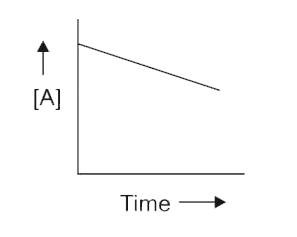Complete Solutions to MULTIPLE CHOICE QUESTIONS of chapter CHEMICAL KINETICS of Class 12 book with complete answers and questions
| Class 12 | CHEMISTRY |
| Chapter | CHEMICAL KINETICS |
| SUPPORT MATERIAL | MULTIPLE CHOICE QUESTIONS |
| Number Of Questions | 25 |
| Academic Year | 2023-24 |
The half life period of a first order reaction is `100^@` seconds. Its rate constant is:
View SolutionIn Arrehenius equation if a graph is plotted between logK and 1/T, the slope of the curve will be:
View SolutionThe rate low for a reaction 2C + D`to` A + E is
`(-d[D])/(dt)=K[C]^2[D]`
if C is present in large excess, the order of the reaction will be:
View SolutionWhat is the activation energy for the reverse of this reaction?
`N_2O_(4(g)) to 2NO_(2(g))`
Data for the given reaction is `Delta`H = 54 KJ/mol and `epsilon_a`=57.2 KJ.
View SolutionThe rate constant of a reaction becomes equal to the pre exponential factor when:
View SolutionThe following graph show that the reaction is:

View SolutionA second order reaction between A and B is elementary reaction:
A+B `to` Product
rate law expression of this reaction will be:
View SolutionThe order and molecularity of the chain reaction, `H_(2(g))+Cl_(2(g)) overset(hv)to HCl`
View SolutionWhich of the following is pseudo first order reaction?
View SolutionA large increase in the rate of a reaction for a rise in temperature is due to
View SolutionFor a creactionj, the following data were obtained:

the order of reaction is:
View SolutionFor the formation of `SO_3` in the following reaction, it is given that
`2SO_2 + O_2 to 2SO_3 " " E_a`= Activation energy
`SO_2 + 1//2O_2 to SO_3 " "E'_a` = Activation energy
View SolutionA first order reaction is 20% complete in one hour. At the end of 3 hrs the extent of the reaction is:
View SolutionRadioactive decay is an example of:
View SolutionAt `227^(@)C` , the presence of catalyst causes the activation energy of a reaction to decrease by `4.606 K cal. `The rate of the reaction will be increased by `: -`
View SolutionThe decomposition of `N_2O_5` occurs as, `2N_2O_5 to 4NO_2 + O_2` and follows first order kinetics, hence:
View SolutionRate of which reactions increases with temperature:
View SolutionFor the reaction, `N_2O_5 to 2NO_2 + O_2` ,
Given `(-d)/(dt)[N_2O_5]=K_1[N_2O_5]`
`d/(dt)[NO_2]=K_2[N_2O_5]`
`d/(dt)[O_2]=K_3[N_2O_5]`, the relation in between of `K_1K_2K_3` is
View SolutionWhich of the following statement is/are correct about order of reaction:
View SolutionWhich one is correct for first order reaction.
View SolutionMatch the column and found out correct option.

View SolutionStatement 1: Lower the activation energy, faster is the reaction.
Statement 2 : Catalyst does not affect activation energy of the reaction.
View SolutionFor first order reaction: `t_(99.9)/t_50`=x , Here x is
View SolutionThe reactions taking place in one step is called ............... reactions.
View SolutionThe order of reaction is ............... determined.
View Solution
MULTIPLE CHOICE QUESTIONS questions and complete solutions for chapter CHEMICAL KINETICS of CBSE COMPLEMENTARY MATERIAL CHEMISTRY (HINGLISH) of Class 12